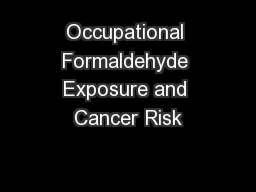

Laura Beane Freeman PhD Occupational and Environmental Epidemiology Branch Division of Cancer Epidemiology and Genetics April 24 2012 Formaldehyde An Important Chemical Ubiquitous in atmosphere and life forms ID: 628256
Download Presentation The PPT/PDF document "Occupational Formaldehyde Exposure and C..." is the property of its rightful owner. Permission is granted to download and print the materials on this web site for personal, non-commercial use only, and to display it on your personal computer provided you do not modify the materials and that you retain all copyright notices contained in the materials. By downloading content from our website, you accept the terms of this agreement.
Slide1
Occupational Formaldehyde Exposure and Cancer Risk
Laura Beane Freeman, Ph.D.Occupational and Environmental Epidemiology BranchDivision of Cancer Epidemiology and GeneticsApril 24, 2012Slide2
Formaldehyde: An Important Chemical
Ubiquitous in atmosphere and life forms >5% of yearly U.S. GDP2.1 million U.S. workers exposed (1995)Fixatives and disinfectantsWood products, resins, molded plastics, crease-resistant fabrics, paper productsEnvironmental exposuresOff-gassing from home furnishings, automobile engines, cigarette smoke, incomplete fuel combustionSlide3
Background: Evidence for Carcinogenicity
Genotoxic Causes DNA-protein cross-links at site of contactInhaled formaldehyde causes nasal tumors in rats3Slide4
Carcinogenicity of Formaldehyde
WHO-IARC review in 2004Sufficient evidence for nasopharyngeal cancerStrong, but not sufficient evidence for leukemiaWHO-IARC review in 2009Sufficient evidence for leukemia, particularly myeloidReaffirmed status for nasopharyngeal cancerNational Toxicology Program Report on Carcinogens 2009Sufficient evidence for nasopharyngeal cancer and myeloid leukemiaEPA ongoingUpdating risk assessment of formaldehydeSlide5
U.S. Occupational StandardOSHA:
0.75 ppm for 8-h time weighted average 2.0 ppm for short-term exposure limitSlide6
Formaldehyde Research: 2 Exposure Scenarios
Study of Funeral Industry WorkersNCI Cohort of Industrial WorkersSlide7
Leukemia among Professionals
* 95% CI does not include 1.0Slide8
Study of Funeral Industry WorkersSlide9
Case Control Study of Funeral Industry Workers
6,808 deaths among 13,994 inactive/deceased funeral directors/embalmersIdentified through professional associations and licensing boards (deaths from 1960-86)168 deaths from lymphohematopoietic malignancies 34 from myeloid leukemia265 controls: deaths due to natural causesMatched by study source, sex, dates of birth and deathSlide10
Study of Funeral Industry Workers: Exposure Assessment
1,278 interviews with next of kin and co-workersWork history, including embalming characteristicsPer job: start/end, funeral home, embalming, # embalmings (autopsied/intact), ventilationPer subject: duration of typical embalming, frequency of spillsSmoking historySlide11
Study of Funeral Industry Workers: Exposure Assessment
Exposure study25 embalmings under controlled conditionsVentilationSolution strengthType of case (intact or autopsy)Continuous measurement of formaldehyde concentration in breathing zoneExposure levels:Average intensity while embalming: 1.7 ppm8-hr time weighted average: 0.2 ppmPeak exposure while embalming: 8.6 ppmSlide12
Cancer in the Funeral Industry: Results
Non-lymphoid LHPMOR
Myeloid Leukemia
OR
Duration (y)
<500 embalmings
<
20 years
>20-34 years
>34 years
REF
0.3
2.0
2.6
p-trend=0.046
REF
0.5
3.2
3.9
p-trend=0.020
# of embalmings
<500
>
500-1422
1423-3068
>3068
REF
0.6
1.8
2.3
p-trend=0.247
REF
1.22.93.0p-trend=0.314
Hauptmann, et al., JNCI 2009
Slide13
Cancer in the Funeral Industry: ResultsSimilar results for other metrics:
Myeloid leukemia: Cumulative exposure: p-trend=0.192Average intensity while embalming: p=trend=0.058TWA8 intensity: p-trend=0.396Peak exposure: p-trend=0.036No associations with other LHPMSlide14
NCI Cohort of Industrial WorkersSlide15
NCI Industrial Cohort StudyMortality study of 25,619 workers in 10 plants
Employed prior to 1966Work histories through 1980Time-dependent exposure metrics 13,951 deaths as of 200442 years of median follow-upSlide16
NCI Industrial Cohort: Relative Risks by Peak Formaldehyde Exposure (ppm)
0
>0-<2.0
2.0-<4.0
>
4.0
RR
1.07
0.59
0.27
0.82
RR
1.0
1.0
1.0
1.0
RR
1.17
0.98
0.81
1.30
RR
1.37*
1.42
1.15
1.78
p-trend
0.02
>0.50
>0.50
0.13
Lymphohemato
Leukemia
Lymphatic leukemia
Myeloid leukemia
Beane Freeman, et al., JNCI. 2009; 101: 751-761.
Slide17
17
RR for Medium and High Peak Formaldehyde Exposure Categories
Exposure-response trend p-values
RR for Peak Medium
High
Date of last work history
`
Myeloid LeukemiaSlide18
18
RR for Medium and High Peak Formaldehyde Exposure Categories
RR for Peak
Medium
High
Myeloid Leukemia
Lymphatic LeukemiaSlide19
RR for Medium and High Peak Formaldehyde Exposure Categories and p-values for Trend Tests Among Exposed Person-years
All HLPNHL
Hodgkin Lymphoma
Multiple Myeloma
Leukemia
Lymphatic Leukemia
Myeloid LeukemiaSlide20
RR for Medium and High Average Intensity Formaldehyde Exposure Categories and p-values for Trend Tests Among Exposed Person-years
All HLP
NHL
Hodgkin Lymphoma
Multiple Myeloma
Leukemia
Lymphatic Leukemia
Myeloid LeukemiaSlide21
Nasopharyngeal Cancer 8 exposed cases All cases in highest peak exposure category:
RR=1.83, p-trend=0.044Consistent with case-control studies of nasopharyngeal cancer and animal studiesHauptmann, et al., Amer J Epidemiol, 2004Slide22
Carcinogenicity of Formaldehyde
WHO-IARC review in 2004Sufficient evidence for nasopharyngeal cancerStrong, but not sufficient evidence for leukemiaWHO-IARC review in 2009Sufficient evidence for leukemia, particularly myeloidReaffirmed status for nasopharyngeal cancerNational Toxicology Program Report on Carcinogens 2009Sufficient evidence for nasopharyngeal cancer and myeloid leukemiaEPA ongoingUpdating risk assessment of formaldehydeSlide23